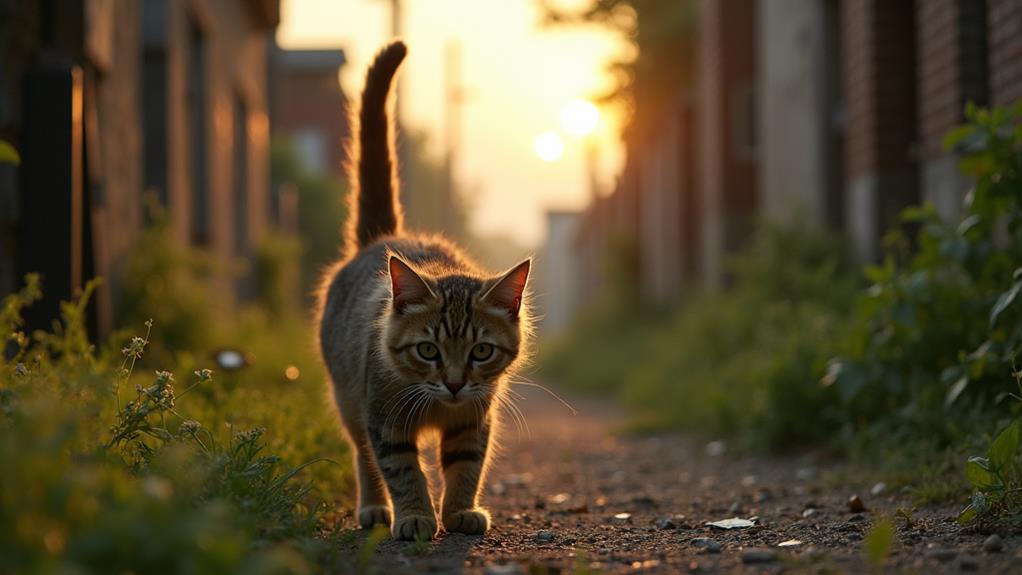How to Train a Feral Cat: Tips for Taming Wild Cats

Taming a feral cat involves patience and understanding. Start by observing their behavior to gauge levels of fear or aggression. Create a safe environment with a cozy hiding spot and make certain it's quiet. Consistently provide food at the same time to build trust, using soft voices and calm movements. Let the cat approach you, gradually introducing treats and toys to form positive ties. Make certain of their health with vaccinations and consider spaying or neutering. Remember, progress varies and may require persistence. Immerse yourself in creating a secure, nurturing space and you'll improve your success with taming these wild cats.
Understanding Feral Cats
Feral cats are fascinating creatures, often misunderstood due to their elusive nature. Born and raised without human contact, these cats rely heavily on their survival instincts, viewing people as potential threats. This wariness often manifests in defensive behaviors like hissing or biting when approached. Feral cats typically live in colonies, which form near reliable food sources. Unfortunately, their average lifespan is less than two years, largely due to environmental dangers such as predators, harsh weather, and scarcity of resources.
Understanding feral cats requires recognizing the significant role that socialization plays in their lives. Younger cats, in particular, are more adaptable and can be tamed with patience and consistent human interaction. However, the process isn't one-size-fits-all; it heavily depends on each cat's maturity and prior experiences. Feral cats that have had negative encounters with humans will likely take longer to tame, if at all.
Responsible management is essential for their well-being. This involves creating safe environments, ensuring access to food and water, and gradually introducing human contact to foster trust. Each step towards socialization helps minimize the dangers they face while enhancing their quality of life.
Assessing the Cat's Behavior
When you're evaluating a cat's behavior, keen observation is your greatest tool. Start by examining the feral cat's body language from a distance. Look for signs of fear or aggression, such as hissing, growling, or puffed-up fur. These signals suggest you should proceed with caution. Avoid direct eye contact and sudden movements, which can be perceived as threats.
Next, pay attention to the cat's health by noting any limping or excessive grooming. These may be signs of illness or injury needing intervention. Observe if the cat is solitary or part of a colony by watching its interactions with other cats. This insight can help you understand its social tendencies.
Identify the cat's preferred hiding spots and routines. This knowledge will aid in establishing a feeding schedule that aligns with its behavior, helping build trust over time. Consistent feeding can create positive associations and bridge the gap between you and the cat.
Setting Realistic Expectations

Understanding the time commitment involved is vital when you're setting realistic expectations for taming a feral cat. Taming can take weeks or even months, so patience is key. Younger feral cats, especially those under 8 weeks, generally adapt more quickly due to their developmental stages and socialization needs. However, older cats might require more time and gradual interaction to build trust. It's significant to take into account each cat's age, past experiences, and personality when setting your expectations.
Start by focusing on building trust through consistent feeding and gentle engagement. Avoid forcing contact, as this can overwhelm the cat and hinder progress. Remember, every feral cat is unique, and their response to human interaction can vary considerably. Some might never fully shift to indoor living or become lap cats, and that's okay. For these individuals, creating a comfortable outdoor caretaker situation might be a more suitable goal.
Throughout this process, patience is essential. Rushing the cat can lead to setbacks. Gradual exposure and positive reinforcement will help foster trust and socialization over time. By setting realistic expectations and being patient, you'll likely see progress in the cat's handling and interaction abilities.
Creating a Safe Environment
Building trust with a feral cat requires more than just patience; it also demands creating a safe environment where the cat can feel secure. Start by selecting a small, confined space like a bathroom or small room. This helps the cat acclimate to its new surroundings without feeling overwhelmed. Verify the area includes necessities such as food, water, and a litter box. It's vital to remove any hazards, such as breakable items, and secure potential escape routes to keep the environment safe.
To make the space more inviting:
- Create a hiding spot: Provide a cozy area where the cat can retreat when stressed. This could be a box or a covered bed, giving them a secure place.
- Use familiar scents: Place worn clothing or blankets with your scent in the room. Familiar smells can comfort the cat and help it associate the area with security.
- Maintain a quiet atmosphere: Keep noise to a minimum during the initial days to allow the cat to investigate at its own pace.
- Monitor the necessities: Regularly check that food, water, and litter are fresh and accessible, further guaranteeing the cat's comfort.
Creating this safe environment sets the foundation for your feral cat's adjustment.
Building Trust Gradually

Trust is the cornerstone of any relationship, and with a feral cat, it's no different. To build that trust, start by providing consistent meals at the same time each day. This routine fosters a sense of security, making the cat more comfortable with your presence. In terms of interactions, use soft voices and remain calm. Avoid sudden movements; they can be startling. Let the cat approach you on its own terms. By allowing this, you're encouraging trust-building and minimizing its fear.
Introduce treats and toys gradually into the environment. They act as positive associations, encouraging the cat to engage with you while reinforcing that your presence is safe and enjoyable. Always keep an eye on the cat's body language. It communicates a lot about how it feels. Respect its space and avoid direct eye contact, as this can be perceived as threatening. Instead, focus on being a reassuring presence. Over time, these gentle approaches and calm interactions will nurture a trusting relationship. Remember, patience is critical. Each small step in building trust is a victory, bringing you closer to taming your feral friend.
Using Food as Motivation
To effectively motivate a feral cat, food becomes a key tool in your repertoire. Start by using dry cat food as an initial enticement. It's less intimidating and helps establish a consistent feeding routine that builds trust over time. Place food and water bowls in a quiet location and gradually move them closer to your position during feeding sessions. This encourages the cat to approach without feeling threatened, fostering engagement.
Here's a simple plan to keep in mind:
- Feeding Routine: Stick to a consistent feeding schedule. Cats thrive on predictability, which helps them develop a sense of security.
- Positive Associations: Introduce treats during feeding to reinforce good behavior and create positive associations with your presence. This can greatly increase the cat's comfort level.
- Monitor and Adjust: Pay attention to the cat's response. Adjust your approach based on their comfort level and willingness to engage. If they seem hesitant, give them more space.
- Build Trust Gradually: Over time, as the cat becomes more comfortable, they'll associate you with nourishment and safety, leading to heightened trust.
Introducing Human Interaction

When you're ready to introduce human interaction, start by gradually increasing your presence during feeding times. This approach creates a positive association between you and food, helping to build trust. As you do this, use calm voices and gentle movements to keep the cat at ease. Abrupt noises or actions can startle them, hindering the taming process. Instead, focus on making your presence as non-threatening as possible.
Allow the cat to initiate contact. Letting them approach when they're ready fosters a sense of security and control, which is vital for building trust. During these interactions, incorporate treats and toys. These elements can encourage positive experiences and reinforce your bond. Offering a treat after a successful interaction or engaging them with a toy can make your presence more rewarding.
Be attentive to the cat's body language to gauge their comfort levels. If the cat appears relaxed and curious, you're on the right track. If they seem tense or frightened, give them space and adjust your approach. By respecting their comfort levels, you guarantee a respectful and effective introduction to human interaction.
Managing Health and Safety
As your bond with the feral cat strengthens through positive interactions, it's vital to prioritize their health and safety. Regular veterinary visits are fundamental to catch potential illnesses early, safeguarding their overall well-being. You should consider the following steps to manage their health effectively:
- Spaying or Neutering: This not only prevents unwanted litters but also reduces health risks and improves their behavior. It's a significant step to guarantee a healthier life for feral cats.
- Vaccinations: Important for protecting feral cats against common feline diseases, vaccinations make them less vulnerable to health issues in their outdoor environments. Make certain to keep their vaccinations up-to-date.
- Creating a Safe Indoor Space: Once socialized, provide a secure indoor space with necessities like food, water, and a litter box. This helps minimize stress and promotes acclimatization to a new home environment.
- Monitoring Health and Behavior: Keep a close eye on their health and behavior after taming. Any signs of distress or illness should be addressed immediately with veterinary care to prevent further complications.
Long-Term Care Strategies

Caring for a feral cat over the long term involves establishing a stable routine and environment that supports their health and well-being. Start by creating a safe and sheltered environment that includes basics like food, water, and litter. This helps feral cats acclimate to their new surroundings and reduces stress. Implement a consistent feeding schedule, which not only provides nutritional stability but also fosters a sense of security.
Providing a high-protein diet is vital, especially for growing kittens. Special kitten food is recommended to meet their unique nutritional needs and support their development. Regular veterinary check-ups are important for maintaining the health of feral cats. Make sure they're vaccinated and spayed or neutered to prevent the spread of diseases and manage population control.
Understanding cat body language is key to managing behaviors and making certain the cat feels safe. It helps you interpret their comfort levels and adjust your approach accordingly. Gradually socialize the cat by spending time near them and speaking softly to build trust. Over time, this patient approach will help the feral cat become more accustomed to human interaction, securing a healthier and happier future.
Community Support Tips
Community support often plays an important role in effectively managing and caring for feral cat populations. By engaging with community organizations like Alley Cat Allies, you can access valuable resources and educational materials to help manage feral cats through TNR programs. These programs are vital for controlling population growth and improving the well-being of these cats. Getting involved with local animal welfare organizations can also have a significant impact, as these groups often rely on donations to fund spay/neuter programs and medical care.
Here are some practical ways you can contribute:
- Volunteer Opportunities: Get involved by fostering feral kittens or helping out at adoption events. These activities not only assist in socializing cats but also strengthen local rescue efforts.
- Raising Awareness: Utilize social media to spread the word about feral cat issues. Sharing experiences and tips can connect you with fellow advocates and amplify your impact.
- Veterinary Support: Encourage local veterinarians to volunteer their services. Their involvement can greatly improve efforts and promote responsible pet ownership.
- Donations: Financial contributions to animal welfare organizations support vital services like TNR programs and medical care, making a tangible difference in the community.




